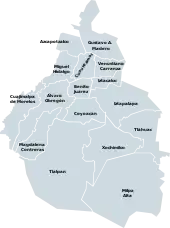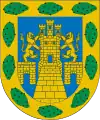Boroughs of Mexico City
Mexico City is one of the 32 federal entities of Mexico, the others being the 31 states. It was named Distrito Federal (Federal District) up to February 5, 2016, when it was officially renamed the Ciudad de México.[1] According to the 2020 Mexican Census, it is the second most populated entity with 9,209,944 inhabitants and the smallest by land area spanning 1,494.3 square kilometres (577.0 sq mi).[2][3]
_in_Mexico_(zoom).svg.png.webp)

Despite containing the word "City", it is not governed as a city but as a unit consisting of multiple subdivisions. As a result of the Political Reforms enacted in 2016, it is no longer designated as a federal district and became a city, a member entity of the Mexican federation, seat of the Powers of the Union and the capital of Mexico.[4]
Mexico City is not organized into municipalities. Instead, it is divided into 16 boroughs, officially designated as Alcaldías in Spanish. Headed by a mayor, these boroughs kept the same territory and name as the former delegaciones, while expanding their local government powers.[4] Boroughs are considered as third-level subdivisions for statistical data collection and cross-country comparisons. The traditional center of Mexico City comprises four boroughs: Benito Juárez, Cuauhtémoc, Miguel Hidalgo and Venustiano Carranza.
The largest borough by population is Iztapalapa, with 1,835,486 residents, while the smallest is Milpa Alta with 152,685 residents. Iztacalco is the most densely populated subdivision in Mexico.[2] The largest borough by land area is Tlalpan which spans 314.50 km2 (121.43 sq mi), and the smallest is Iztacalco with 23.10 km2 (8.92 sq mi).[3]
The most recent boroughs are Benito Juárez, Cuauhtémoc, Miguel Hidalgo and Venustiano Carranza, all established in 1970 out of the former circumscription of Mexico City.[5]
Boroughs
| Name | Population (2020)[2] |
Population (2010)[6] |
Change | Land area[3] | Population density (2020) |
Incorporation date[5] | Mayor | |
|---|---|---|---|---|---|---|---|---|
| km2 | sq mi | |||||||
| Álvaro Obregón[lower-alpha 1] | 759,137 | 727,034 | +4.4% | 95.9 | 37.0 | 7,915.9/km2 (20,502.1/sq mi) | February 15, 1826 | |
| Azcapotzalco | 432,205 | 414,711 | +4.2% | 33.5 | 12.9 | 12,901.6/km2 (33,415.1/sq mi) | August 6, 1826 | |
| Benito Juárez | 434,153 | 385,439 | +12.6% | 26.7 | 10.3 | 16,260.4/km2 (42,114.3/sq mi) | December 29, 1970 | |
| Coyoacán | 614,447 | 620,416 | −1.0% | 53.9 | 20.8 | 11,399.8/km2 (29,525.2/sq mi) | August 6, 1824 | |
| Cuajimalpa | 217,686 | 186,391 | +16.8% | 71.2 | 27.5 | 3,057.4/km2 (7,918.6/sq mi) | July 28, 1899 | |
| Cuauhtémoc | 545,884 | 531,831 | +2.6% | 32.5 | 12.5 | 16,796.4/km2 (43,502.6/sq mi) | December 29, 1970 | |
| Gustavo A. Madero[lower-alpha 2] | 1,173,351 | 1,185,772 | −1.0% | 87.9 | 33.9 | 13,348.7/km2 (34,573.0/sq mi) | May 6, 1861 | |
| Iztacalco[lower-alpha 3] | 404,695 | 384,326 | +5.3% | 23.1 | 8.9 | 17,519.3/km2 (45,374.7/sq mi) | March 5, 1862 | |
| Iztapalapa | 1,835,486 | 1,815,786 | +1.1% | 113.2 | 43.7 | 16,214.5/km2 (41,995.5/sq mi) | March 5, 1862 | |
| La Magdalena Contreras | 247,622 | 239,086 | +3.6% | 63.4 | 24.5 | 3,905.7/km2 (10,115.7/sq mi) | December 31, 1928 | |
| Miguel Hidalgo | 414,470 | 372,889 | +11.2% | 46.4 | 17.9 | 8,932.5/km2 (23,135.2/sq mi) | December 29, 1970 | |
| Milpa Alta | 152,685 | 130,582 | +16.9% | 298.2 | 115.1 | 512.0/km2 (1,326.1/sq mi) | February 15, 1826 | |
| Tláhuac[lower-alpha 4] | 392,313 | 360,265 | +8.9% | 85.9 | 33.2 | 4,567.1/km2 (11,828.7/sq mi) | February 15, 1826 | |
| Tlalpan[lower-alpha 5] | 699,928 | 650,567 | +7.6% | 314.5 | 121.4 | 2,225.5/km2 (5,764.1/sq mi) | April 8, 1825 | |
| Venustiano Carranza | 443,704 | 430,978 | +3.0% | 32.5 | 12.5 | 13,652.4/km2 (35,359.6/sq mi) | December 29, 1970 | |
| Xochimilco | 442,178 | 415,007 | +6.5% | 114.1 | 44.1 | 3,875.4/km2 (10,037.1/sq mi) | August 6, 1826 | |
| Mexico City | 9,209,944 | 8,851,080 | +4.1% | 1,494.3 | 577.0 | 6,163.4/km2 (15,963.1/sq mi) | — | — |
| Mexico | 126,014,024 | 112,336,538 | +12.2% | 1,960,646.7 | 757,010 | 64.3/km2 (166.5/sq mi) | — | — |
Notes
- Álvaro Obregón was originally incorporated as San Ángel, changing its name on December 31, 1941.[5]
- Gustavo A. Madero was originally incorporated as Guadalupe Hidalgo, changing its name on December 31, 1941.[5]
- Iztacalco was merged with Gustavo A. Madero (at that time known as Guadalupe Hidalgo) from 1903 to 1921.[5]
- Tláhuac was merged with Xochimilco from 1903 to 1928.[5]
- Tlalpan was originally incorporated as San Agustín de las Cuevas, changing its name on September 25, 1827.[5]
References
- "General Agreement of the Plenary of the Federal Judiciary Council by which the name of the Federal District is changed to Mexico City" (in Spanish). Diario Oficial de la Federación. Retrieved 2021-03-01.
- "Censo de Población y Vivienda 2020 - SCITEL" (in Spanish). INEGI. Retrieved 2021-01-27.
- "México en cifras - Medio Ambiente - Ciudad de México" (in Spanish). INEGI. Retrieved February 12, 2021.
- "Constitution of Mexico City" (PDF) (in Spanish). Gobierno de la Ciudad de México. Retrieved 2021-02-08.
- Distrito Federal División Territorial de 1810 a 1995 (PDF) (in Spanish). Mexico: INEGI. 1996. ISBN 970-13-1494-8.
- "Censo de Población y Vivienda 2010 - SCITEL" (in Spanish). INEGI. Retrieved 2021-01-27.
External links
 Media related to Municipalities in Mexico City at Wikimedia Commons
Media related to Municipalities in Mexico City at Wikimedia Commons- Government of Mexico City official website (Spanish)
